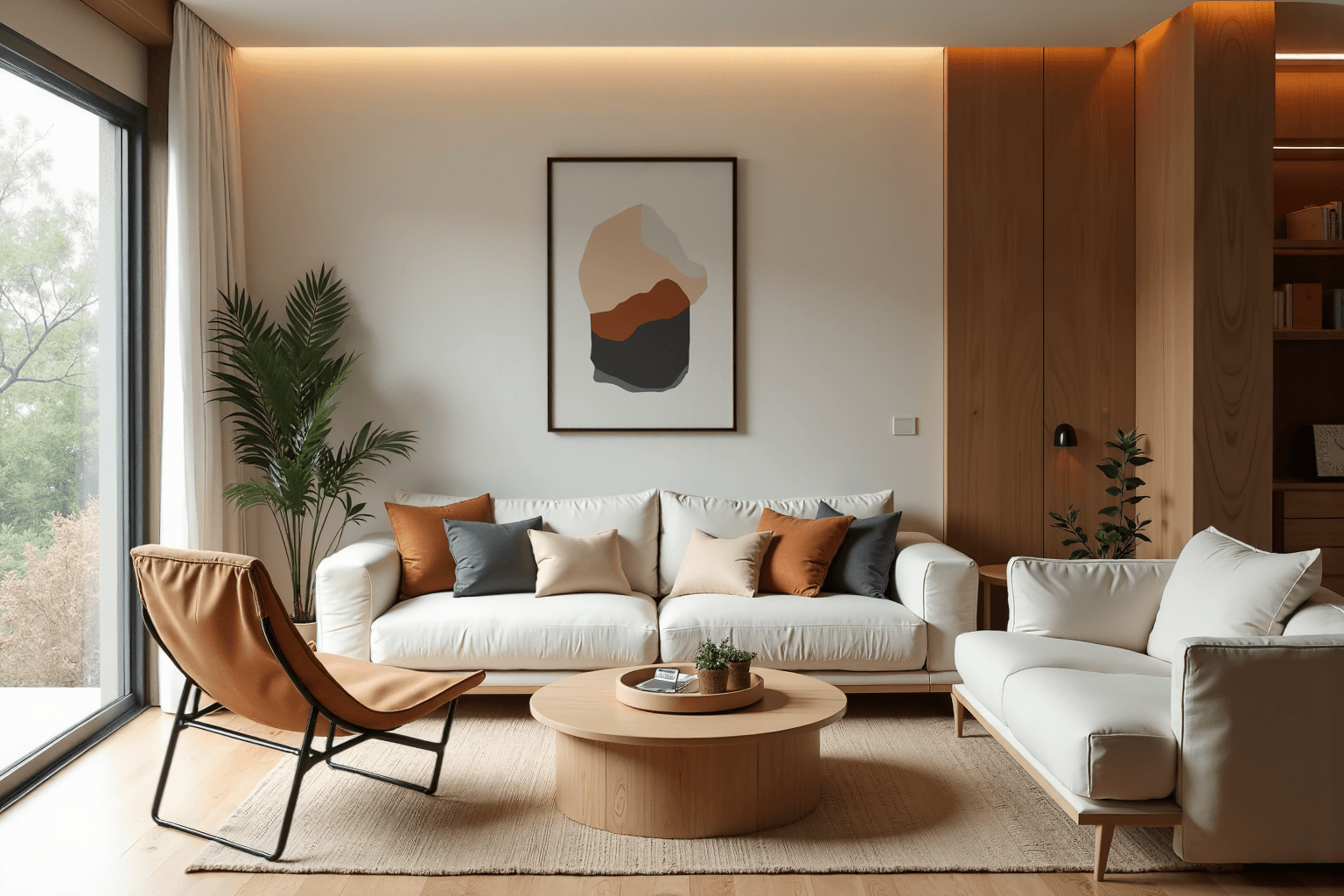Embracing the Japandi Tech-Zen Philosophy
In our increasingly technology-driven world, the quest for a balanced home environment that fosters both functionality and tranquility has become paramount. The constant influx of digital information and devices can often disrupt the serenity we seek within our living spaces. This is where the Japandi design philosophy offers a compelling solution, blending the clean lines and functional comfort of Scandinavian hygge with the minimalist elegance and mindful simplicity of Japanese Zen. Japandi design acts as a bridge between these two distinct yet complementary aesthetics, creating a harmonious space where technology serves to enhance relaxation rather than disrupt it.
This comprehensive guide will walk you through creating a Japandi tech-zen living room, a sanctuary designed to promote peace and well-being in the digital age. The core of Japandi lies in its ability to curate a sense of calm amidst the complexities of modern life. A 2022 survey by the American Society of Interior Designers (ASID) revealed a growing trend towards minimalist and nature-inspired design, with 78% of respondents citing a desire for homes that evoke a sense of peace and well-being.
Japandi directly addresses this need by emphasizing natural materials, neutral color palettes, and decluttered spaces. Think warm wood tones, soft textures, and handcrafted ceramics juxtaposed with sleek, integrated technology. This thoughtful fusion creates a living room that is both aesthetically calming and highly functional, catering to both our physical and psychological needs. Imagine a space where the gentle glow of a smart lighting system mimics the natural daylight cycle, promoting better sleep and a more relaxed atmosphere.
Picture a living room where a curated soundscape, effortlessly controlled by an integrated sound system, sets the mood for tranquility. This approach extends beyond mere aesthetics. Japandi tech-zen is about creating an intentional living experience. By carefully selecting technology that seamlessly integrates into the design, we can minimize visual clutter and maximize functionality. Concealed speakers, hidden charging stations, and streamlined smart home hubs contribute to a serene environment where technology enhances, rather than dominates, the space.
This mindful integration allows us to enjoy the benefits of modern technology without sacrificing the tranquility that is essential for well-being. Furthermore, Japandi encourages us to evaluate our relationship with technology, prompting us to choose devices that truly add value to our lives and contribute to a sense of calm. This curated approach to technology fosters a more mindful and intentional way of living, transforming our living rooms into true sanctuaries from the stresses of modern life.
The emphasis on natural elements in Japandi design further contributes to a sense of grounding and connection to the natural world. Incorporating elements like indoor plants, bamboo accents, and natural fiber rugs not only enhances the aesthetic appeal but also promotes a healthier indoor environment. Studies have shown that incorporating biophilic design elements can reduce stress levels and improve cognitive function, further reinforcing the sense of zen that Japandi aims to achieve. By embracing the principles of Japandi design and thoughtfully integrating technology, you can create a living room that is both aesthetically pleasing and functionally optimized for relaxation. This holistic approach fosters a sense of calm and intentionality, transforming your living room into a sanctuary from the stresses of modern life.
Understanding Japandi Design Principles
Japandi design transcends fleeting trends; it represents a conscious lifestyle choice, a harmonious blend of Japanese minimalism and Scandinavian hygge. This design philosophy prioritizes natural materials, neutral color palettes, and decluttered spaces, fostering a sense of tranquility and balance. Imagine warm wood tones of oak or walnut, the soft textures of linen and wool, and the subtle beauty of handcrafted ceramics juxtaposed with sleek, integrated technology. This fusion of natural and man-made elements creates a living room that is both calming and highly functional, a sanctuary where technology enhances rather than disrupts the serene atmosphere.
At the heart of Japandi design lies a deep respect for craftsmanship and the beauty of imperfection. This is reflected in the selection of materials, often showcasing the natural grain of wood or the unique texture of hand-thrown pottery. These elements introduce a sense of wabi-sabi, the Japanese aesthetic that embraces the beauty of imperfection and impermanence, adding depth and character to the space. Think of a live-edge wooden coffee table paired with a textured, neutral-toned rug, creating a grounding, organic centerpiece for your living room.
This appreciation for natural materials extends to textiles, with an emphasis on natural fibers like linen, cotton, and wool in muted tones that complement the overall minimalist aesthetic. The color palette in a Japandi living room is typically grounded in neutral tones, creating a sense of calm and spaciousness. Soft whites, warm grays, and muted earth tones serve as the foundation, allowing the natural beauty of the materials to shine. Accents of soft greens, blues, or earthy terracotta can be introduced through cushions, throws, or artwork, adding subtle pops of color without overwhelming the serene ambiance.
This restrained color scheme contributes to a sense of visual tranquility, promoting relaxation and mindfulness within the space. Decluttering is an essential aspect of Japandi design, contributing to the overall sense of calm and order. Every item should have a purpose and a place, promoting a minimalist lifestyle that values quality over quantity. Integrated technology plays a key role in maintaining this decluttered aesthetic. Concealed storage solutions, such as built-in shelving and hidden compartments, help maximize space while maintaining the clean lines characteristic of Japandi design.
Smart home systems, seamlessly integrated into the design, further enhance the minimalist aesthetic while providing convenient control over lighting, temperature, and entertainment. The furniture in a Japandi living room is carefully selected to complement the overall aesthetic. Pieces are chosen for their clean lines, functionality, and use of natural materials. A low-slung sofa with a simple silhouette, crafted from natural wood and upholstered in a neutral fabric, might be paired with a minimalist armchair made of rattan or bamboo. A sleek, low-profile entertainment console can house integrated technology while maintaining the clean, uncluttered look. The emphasis is on creating a space that is both visually appealing and highly functional, promoting a sense of calm and well-being.
Integrating Technology for a Zen Experience
Smart home technology plays a crucial role in creating a truly zen living room, seamlessly blending functionality with the tranquility of Japandi design. Automated lighting systems, for instance, can mimic natural daylight cycles, promoting better sleep and a more relaxed atmosphere. Imagine waking up to a gentle sunrise simulation, easing you into the day, and transitioning to a calming warm glow as evening approaches. This circadian rhythm-supporting feature, a cornerstone of a tech-zen space, enhances the overall sense of well-being that Japandi promotes.
Integrated sound systems allow for curated soundscapes, transforming your living room into a personalized sanctuary. Whether it’s the gentle sounds of nature or ambient music, these curated audio experiences enhance the minimalist aesthetic and contribute to a calming environment. Smart thermostats ensure optimal temperature control, automatically adjusting to your preferences for a consistently comfortable atmosphere. This seamless integration of technology minimizes distractions, allowing you to fully embrace the present moment, a key element of the Japandi philosophy.
Consider incorporating voice-activated assistants for seamless control of your devices, further minimizing distractions and streamlining daily routines. Imagine effortlessly adjusting the lighting, music, or temperature with simple voice commands, maintaining the uncluttered, minimalist aesthetic of your Japandi living room. Beyond these core elements, integrating technology mindfully can elevate the Japandi experience. Projectors with retractable screens can transform your living room into a minimalist home theater, disappearing seamlessly into the decor when not in use. Smart blinds can be programmed to adjust automatically throughout the day, optimizing natural light and privacy while maintaining the clean lines of the space.
Even incorporating smart aromatherapy diffusers can enhance the sensory experience, subtly introducing calming scents that complement the Japandi aesthetic. The key is to choose technology that enhances the core principles of Japandi: simplicity, functionality, and connection with nature. By thoughtfully curating technology, you create a space that supports both modern convenience and the pursuit of tranquility, a hallmark of both Japanese and Scandinavian design. This intentional integration of technology fosters a deeper sense of peace and presence within your home, aligning perfectly with the Japandi ethos. It’s not about adding technology for technology’s sake, but rather leveraging its capabilities to enhance the serenity and functionality of your space, creating a true Japandi tech-zen oasis.
Decluttering and Maximizing Storage
Decluttering is fundamental to the Japandi aesthetic. It’s not merely about tidying up; it’s a conscious effort to curate your belongings, keeping only items that serve a purpose or bring joy, a principle deeply rooted in both Japanese minimalism and Scandinavian design. In the context of the living room, this translates to a careful assessment of everything from books and decorative objects to electronics and furniture. Before even considering storage solutions, embark on a ruthless decluttering process.
Ask yourself: Does this item spark joy? Is it functional? If the answer to both is no, it’s time to let it go. This initial purge will significantly reduce the amount of storage you actually need. Invest in smart storage solutions that maximize space while maintaining clean lines, a hallmark of both Japanese and Scandinavian design sensibilities. Built-in shelving, hidden compartments within furniture, and minimalist storage boxes are key to achieving this organized, serene environment.
Consider, for instance, a coffee table with lift-top storage for blankets and remotes, or a media console designed to conceal unsightly cables and electronic components. For books, opt for simple, floating shelves rather than bulky bookcases. Even the strategic placement of plants can contribute to a sense of calm, but be mindful of overdoing it – maintain a balance to avoid visual clutter. Minimalist furniture pieces also play a crucial role in decluttering. Choose items with clean lines and integrated storage to maximize space and minimize visual noise.
A platform bed with drawers underneath, or a sofa with built-in shelving, can provide discreet storage without sacrificing style. Opt for multi-functional furniture whenever possible. A daybed, for example, can serve as both a seating area and a guest bed, reducing the need for additional furniture pieces. When selecting furniture, prioritize natural materials like wood, bamboo, and linen to enhance the Japandi aesthetic and create a sense of warmth and tranquility. Consider incorporating smart home technology to further streamline your living room and reduce clutter.
Wireless charging stations can eliminate the need for multiple cables, while smart lighting systems can be controlled via voice commands or a smartphone app, reducing the need for physical switches and remotes. A discreetly placed smart speaker can provide ambient music or white noise to enhance relaxation, while a robot vacuum can help keep the floor clean and clutter-free. The key is to integrate technology seamlessly into the Japandi design, ensuring that it enhances rather than detracts from the overall sense of calm.
The goal is to create a space where every item has a purpose and contributes to the overall sense of calm. This extends beyond mere functionality; it’s about creating a harmonious environment that promotes relaxation and mindfulness. By embracing the principles of decluttering and investing in smart storage solutions, you can transform your living room into a true Japandi sanctuary, a haven from the stresses of modern life. Think of each object as carefully curated, contributing to a sense of intention and tranquility, reflecting the core values of both Japanese and Scandinavian design.
Furniture and Decor Selection
Furniture selection is paramount in establishing the Japandi aesthetic. Prioritize pieces with clean lines and organic silhouettes, favoring natural materials such as sustainably sourced wood, bamboo, and rattan. These materials not only contribute to the visual appeal but also introduce textural depth, creating a space that feels both grounded and inviting. A sofa crafted from light oak with woven rattan accents, for instance, can serve as a focal point, embodying both Scandinavian simplicity and Japanese craftsmanship.
Consider low-profile furniture designs, echoing the traditional Japanese emphasis on proximity to the earth, which enhances the sense of calm and spaciousness. The color palette should remain predominantly neutral, creating a tranquil backdrop for the interplay of textures and natural light. Shades of off-white, beige, and soft gray establish a sense of serenity, while subtle accents of muted greens, blues, or earthy tones inspired by the Japanese landscape introduce a touch of personality and visual interest.
Imagine a muted sage green throw draped over a cream-colored sofa, complemented by a hand-woven indigo cushion, reflecting the natural harmony of the Japandi style. Avoid jarring contrasts, opting instead for gentle gradations that create a soothing, cohesive atmosphere. Handcrafted items are integral to infusing the space with warmth and character. Incorporating artisanal pieces like a ceramic vase with a simple floral arrangement or woven baskets for storage adds a touch of wabi-sabi, the Japanese philosophy of finding beauty in imperfection.
These elements introduce an organic, human touch, contrasting beautifully with the sleek lines of minimalist technology. A hand-thrown clay vase showcasing a single stem or a collection of textured baskets for storing blankets and pillows can personalize the space while adhering to the decluttered aesthetic. Technology integration in a Japandi living room should be seamless and unobtrusive. Conceal wiring and prioritize minimalist designs for electronics. Choose smart speakers that blend with the decor, such as those with a natural wood or fabric finish.
Integrated lighting systems that mimic natural daylight cycles can be controlled via a minimalist wall panel or a voice-activated assistant, further enhancing the sense of technological zen. A sleek, wall-mounted television that can be disguised as artwork when not in use exemplifies this principle of harmonious integration. Ultimately, the Japandi living room should be a sanctuary, a space that promotes relaxation and mindfulness. Every element, from the furniture to the technology, should contribute to this overarching goal. By carefully curating each piece and prioritizing functionality, sustainability, and aesthetic harmony, you can create a living room that embodies the essence of Japandi living, fostering a sense of tranquility and balance in your everyday life.
Creating Your Japandi Oasis
By embracing the principles of Japandi design and thoughtfully integrating technology, you can create a living room that is both aesthetically pleasing and functionally optimized for relaxation. This approach fosters a sense of calm and intentionality, transforming your living room into a sanctuary from the stresses of modern life. The fusion of Japanese minimalism and Scandinavian hygge, the core of Japandi, provides a framework for curating a space that is both visually calming and technologically advanced.
Imagine a living room where the warm glow of automated, dimmable lighting complements the natural textures of a sustainably sourced wooden coffee table, all while a curated playlist flows seamlessly from a hidden, integrated sound system. This is the essence of a Japandi Tech-Zen living room. The key to achieving this harmonious balance lies in the careful selection and integration of smart home technology. Instead of overwhelming the space with gadgets, the focus is on seamless integration and intuitive control.
Voice-activated assistants can manage lighting, temperature, and entertainment, minimizing visual clutter and maximizing functionality. Smart lighting systems, mimicking natural daylight cycles, can enhance mood and promote well-being, a core tenet of both Scandinavian hygge and Japanese Zen. Imagine transitioning from a bright, energizing morning light to a warm, calming evening glow, all controlled effortlessly through a minimalist interface. This thoughtful integration of technology allows you to create a truly personalized and responsive environment. Decluttering and maximizing storage are paramount to maintaining the clean lines and minimalist aesthetic central to Japandi design.
Invest in furniture pieces with built-in storage, such as ottomans with hidden compartments or sleek consoles with integrated drawers. Utilize vertical space with minimalist shelving units crafted from natural materials like bamboo or light oak, showcasing a curated selection of books and decorative objects. This strategic approach to storage ensures that every item has a designated place, contributing to a sense of order and tranquility, fostering the zen-like atmosphere that defines this design philosophy. The result is a space that feels open, airy, and conducive to relaxation.
Furthermore, the selection of furniture and decor plays a crucial role in establishing the Japandi aesthetic. Opt for pieces with clean lines and natural materials, prioritizing functionality and craftsmanship. A low-slung sofa upholstered in a neutral linen fabric paired with a handwoven rug made from sustainable fibers creates a grounding, inviting atmosphere. Introduce subtle accents of color with carefully chosen cushions in muted tones of green, blue, or earthy terracotta, reflecting the natural world. Incorporating handcrafted ceramic vases, woven baskets, or a single, statement piece of Japanese calligraphy adds a touch of warmth and personality, further enhancing the sense of mindful curation that defines the Japandi Tech-Zen living room.
This intentional approach to design creates a space that is not only visually appealing but also deeply personal and reflective of your individual style. Ultimately, creating a Japandi Tech-Zen living room is about curating a space that nurtures both physical and mental well-being. By thoughtfully blending the principles of minimalist design, smart home technology, and the natural world, you can transform your living room into a sanctuary, a space where you can escape the demands of modern life and reconnect with a sense of inner peace. This intentional approach to design fosters a harmonious balance between technology and tranquility, resulting in a living room that is both functional and deeply restorative, a true oasis of calm in the heart of your home.



